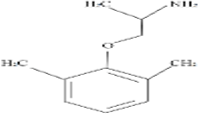Abstract
The work aims to develop an appropriate method for mexiletine with 35-65% recovery by the LPE method with efficient and selective efficacy of the IS and analyte for the analysis under Liquid Chromatography-Mass Spectrometry/ Mass Spectrometry. This method also reveals the bio-availability and bio-equivalence report for Internal Standard & working standard. At first, the selection of proper IS. The Internal standard should be structurally more similar to mexiletine. The selection of method plays a major role in which extraction procedure is done either by LPE or SPE. The selection of separation procedure should be either isocratic or gradient. Selection of column on bases separation principle of the compound. Since separation is the major principle for chromatography. Argon and Nitrogen Gas is used as carries with a flow-rate of 2L min. Temperature at 20°C, the pressure at 20psi. If the instrument doesn't show any peak or response in after loading sample, check the columns is an aqueous or reverse-phase and then submit the sample. Check all the solution and column and temperature and system stability before loading the sample. After loading the sample, must form calibration curve it must form linearity. The method found should possess the following parameters Specific & Selectivity, Precision & Accuracy. The work aims to develop a simple, elegant way for quantification of a molecule and the method determined will have recovery of 35-65% worldwide. This quantification will be further utilized in Full-Method Validation.
Full text article
References
Bastedo, W.A. 1939. The United States Pharmacopeial Convention, Inc., Decennial Period, 1930-1940 Committee of Revision of The United States Pharmacopeia. Journal of the American Medical Association, 113(2):1–164.
Breithaupt, H., Wilfling, M. 1982. Determination of mexiletine in biological fluids by high- performance liquid chromatography. Journal of Chromatography B: Biomedical Sciences and Applications, 230(1):97–105.
Chen, X., Ji, Z. L., Chen, Y. Z. 2002. TTD: therapeutic target database. Nucleic acids research, 30(1):412–415.
Chinushi, M., Tagawa, M., Sugiura, H., Komura, S., Hosaka, Y., Washizuka, T., Aizawa, Y. 2003. Ventricular Tachyarrhythmias in a Canine Model of LQT3. Arrhythmogenic Effects of Sympathetic Activity and Therapeutic Effects of Mexiletine. Circulation Journal, 67(3):263–268.
Fabritz, L., et al. 2003. Effect of pacing and mexiletine on dispersion of repolarisation and arrhythmias in ∆KPQ SCN5A (long QT3) mice. Cardiovascular Research, 57(4):1085–1093.
Hancox, J.C. 2000. Antiarrhythmics—from cell to clinic: past, present, and future. Heart, 84(1):14– 24.
Hashimoto, K. 1984. Effects of new antiarrhythmic drugs (aprindine, mexiletine, propafenone, tocainide, SUN-1165) on canine ventricular arrhythmia models. Japanese Journal of Pharmacology, 36:16–16.
Hu, W., Sorrentino, C., Denison, M.S., Kolaja, K., Fielden, M.R. 2007. Induction of Cyp1a1 Is a Non-specific Biomarker of Aryl Hydrocarbon Receptor Activation: Results of Large-Scale Screening of Pharmaceuticals and Toxicants in Vivo and in Vitro. Molecular Pharmacology, 71(6):1475–1486.
Jerome, J. 1981. The United States Pharmacopeia, edition 20; The National Formulary. JAMA: The Journal of the American Medical Association, 245(4):1–397.
Kannankeril, P.J., Fish, F.A. 2003. Management of common arrhythmias and conduction abnormalities. Progress in Pediatric Cardiology, 17(1):41–52.
Kaushik, S., Alexander, K. S. 2003. A Modified Reverse-Phase HPLC Method for the Analysis of Mexiletine Hydrochloride. Journal of Liquid Chromatography and Related Technologies, 26(8):1287–1296.
Kempton, J., Manoukian, A., Levine, B., Smialek, J. 1994. A Mexiletine Intoxication. Journal of Analytical Toxicology, 18(6):346–347.
Lanchote, V.L., Bonato, P.S., Dreossi, S.A., Gonçalves, P.V., Cesarino, E.J., Bertucci, C. 1996. High- performance liquid chromatographic determination of mexiletine enantiomers in plasma using direct and indirect enantioselective separations. Journal of Chromatography B: Biomedical Sciences and Applications, 685(2):281–289.
Liao, R., Liu, J., Zhang, W., et al. 2020. Individualized Red-Cell Transfusion Strategy for Non-Cardiac Surgery in Adults: A Randomised Controlled Trial. The Lancet, pages 1–61.
Minnigh, M.B., Alvin, J.D., Zemaitis, M.A. 1994. Determination of plasma mexiletine levels with gas chromatography—mass spectrometry and selected-ion monitoring. Journal of Chromatography B: Biomedical Sciences and Applications, 662(1):118–122.
Olszowy, P., Szultka, M., Ligor, T., Nowaczyk, J., Buszewski, B. 2010. Fibers with polypyrrole and polythiophene phases for isolation and determination of adrenolytic drugs from human plasma by SPME-HPLC. Journal of Chromatography B, 878(24):2226–2234.
Pérez-Lozano, P., García-Montoya, E., Orriols, A., Miñarro, M., Ticó, J. R., Suñé-Negre, J. M. 2004. Development and validation of a new HPLC analytical method for the determination of alprazolam in tablets. Journal of Pharmaceutical and Biomedical Analysis, 34(5):979–987.
Pinto, D., Coutinho, D., Carvalho, K. 2020. Pharmacological profiling of JME-173, a novel mexiletine derivative combining dual anti-inflammatory/anti-spasmodic functions and limited action in Na+ channels. European Journal of Pharmacology, 885:173367.
Shibata, N., Akabane, M., Minouchi, T., Ono, T., Shimakawa, H. 1991. Fluorimetric determination of mexiletine in serum by high-performance liquid chromatography using pre-column derivatization with fluorescamine. Journal of Chromatography B: Biomedical Sciences and Applications, 566(1):187– 194.
Shimizu, W., Antzelevitch, C., Suyama, K. 2000. Effect of Sodium Channel Blockers on ST Segment, QRS Duration, and Corrected QT Interval in Patients with Brugada Syndrome. Journal of Cardiovascular Electrophysiology, 11(12):1320–1329.
Szultka-Młyńska, M., Bajkacz, S., Baranowska, I., Buszewski, B. 2018. Structural characterization of electrochemically and in vivo generated potential metabolites of selected cardiovascular drugs by EC-UHPLC/ESI-MS using an experimental design approach. Talanta, 176:262–276.
Takahara, A., Sugiyama, A., Satoh, Y., Hashimoto, K. 2003. Effects of mexiletine on the canine model of sparfloxacin-induced long QT syndrome. European Journal of Pharmacology, 476(1-2):115–122.
Valdivia, C., et al. 2002. A novel SCN5A arrhythmia mutation, M1766L, with expression defect rescued by mexiletine. Cardiovascular Research, 55(2):279–289.
Authors

This work is licensed under a Creative Commons Attribution-NonCommercial-NoDerivatives 4.0 International License.

